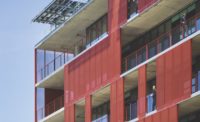With cities worldwide facing daunting environmental challenges on a global scale, a multidisciplinary team at Arup seeks to create a model for how cities can develop carbon neutrally
Dongtan’s ecological footprint
The Stockholm Environment Institute (SEI) describes the global environmental imbalance succinctly: “Sustainability requires living within the regenerative capacity of the planet. Currently, human demand on the planet is exceeding the planet’s regenerative capacity by about 20 percent. This is called ‘overshoot.’ ”


Arup is developing an ideal ecological footprint for Dongtan to guide the master plan and prevent overshoot. The new city’s ecological footprint will be determined by a modeling program called the Resources and Energy Analysis Program (REAP), developed by SEI and the Center for Urban and Regional Ecology at the University of Manchester. Unlike the traditional focus on air and water pollution, REAP concentrates on measuring the amount of resources consumed by the number of individuals occupying a defined area.
The best ecological footprint, of course, balances (nature’s) supply and (human) demand, which is the goal at Dongtan. Head and his team are using REAP to determine the effectiveness of their planning decisions in achieving sustainability, as well as Arup’s own sustainable design assessment tool, the Sustainable Project Appraisal Routine (SPeAR). The footprint will reveal how much productive land and sea is needed to provide the energy, food, and materials for daily consumption, and how much land is required to absorb human-generated waste. The program also calculates the emissions generated from the oil, coal, and gas burned, and determines how much land, air, and water is required to disperse these emissions.
Ecological footprinting is not without critics. Some experts argue that by applying generalizations and averages to per capita analysis, while not accounting for multiple usages of the same land, for instance, oversimplifies the conclusions. SEI claims that REAP is “the only software tool that can convert household [and commercial] expenditure at the national level into its associated environmental impact,” rendering its forecasts more accurate at the product level with the inclusion of “bottom-up” data.
The U.K. has a short, but intense, history of ecological footprinting. For years prior to Dongtan, British architect Bill Dunster and Arup had pursued the viability of harnessing renewable resources, achieving closed-loop material use, and creating site-resource autonomy. In 1999, the Peabody Trust, one of London’s largest affordable housing providers, selected Arup, Bill Dunster Architects (since renamed BDa ZEDfactory), and the BioRegional Development Group to test their ideas creating the Beddington Zero (fossil) Energy Development (BedZED). The goal of the 83-home, mixed-income housing development in South London was to prove that carbon-neutral projects were cost-effective, practical, and therefore ready for the mainstream marketplace.
For the Dongtan team, BedZED’s most important lesson was its holistic design approach, which eliminated obsolete systems from the beginning, rather than tacking on sustainability features in an effort to increase performance. Arup is applying total design integration to the project through a series of design specifications for architects. While construction on infrastructure is slated to begin this year, no architects have been engaged for the building program.
Think globally, act locally
Innovation should not be conceded entirely to the U.K. or Europe. Progress can be seen domestically at the local and state levels, as federal guidelines are now being fortified with legislation. With much fanfare, Governor Arnold Schwarzenegger of California recently established a groundbreaking Low Carbon Fuel Standard (LCFS) for transportation fuels sold in the state. Elsewhere, cities are concentrating on buildings and land use, confronting the fact that U.S. buildings annually consume 43 percent of the nation’s energy and generate 35 percent of its CO2 emissions.
ine years ago, Austin, Texas, recognized the impact that residential construction was having on the local environment and established a Green Building Program to provide financial incentives—not just voluntary guidelines—for all residential, commercial, and multifamily projects. Austin Energy, the city’s community-owned utility, has developed renewable energy sources, including wind turbines, landfill methane gas recovery projects, and solar energy sites. Seattle’s public electricity utility has adopted a policy of zero-net greenhouse gas emissions by selling its stake in a coal-fired steam plant and mitigating emissions from its remaining fossil-fuel plant. These aren’t new strategies, but they are now being widely embraced by a design community that is more engaged in the bigger regional picture of each individual architectural project.
A zero-carbon nation will undoubtedly take more generations to achieve, but the political will to do so is gaining momentum and having Dongtan as a model will certainly help matters. This growing interest reveals a commitment to long-term goals, which has effectively been missing since Benjamin Franklin argued that the public has a right to live in environmentally healthy communities.




Post a comment to this article
Report Abusive Comment